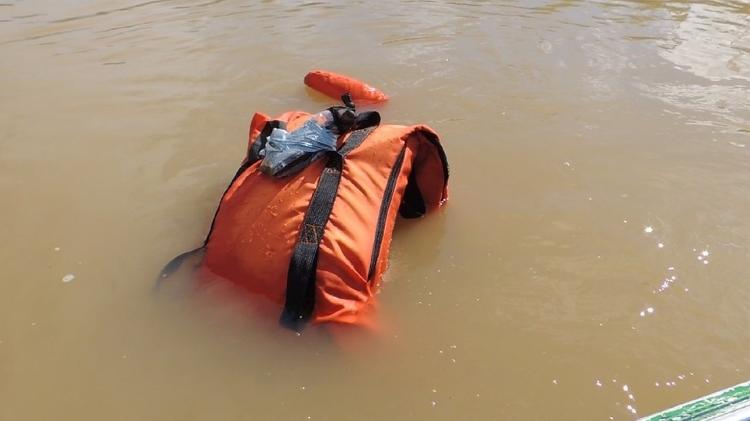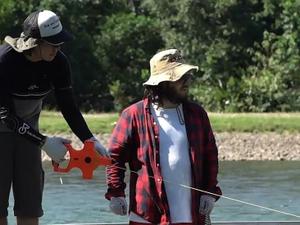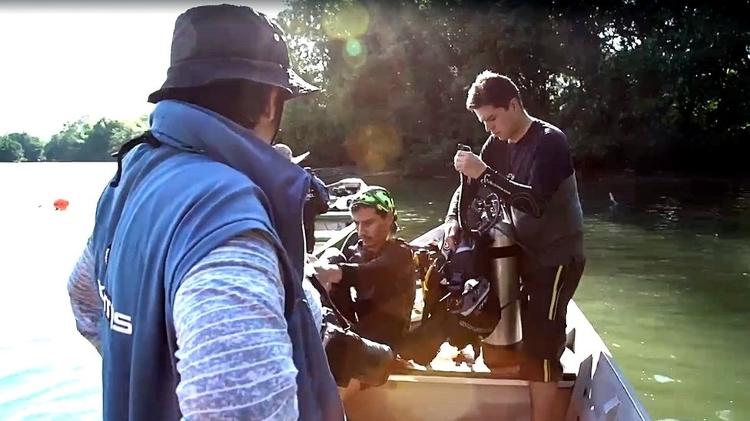How does the body of a missing person turn into a river in Colombia?
A few years ago, Colombian microbiologist Luz Adriana Pérez and forensic anthropologist Ana Carolina Guatame asked this question during a research project involving victims of armed conflict on Colombian soil.
And the interrogation stemmed from the testimonies they had collected: dozens of them cited paramilitary groups as the main culprits of the violence – bodies thrown into rivers to avoid being found.
In fact, Ever Veloza, a paramilitary commander better known as HH, once said, “If they drain the Magdalena River, they’ll find the largest cemetery in the country.”
Colombian authorities reported that so far, more than 1,000 people considered victims of the conflict that has gripped the country for more than 50 years have been rescued from Colombia’s rivers.
“But according to the stories we’ve heard and the official data, the number is much higher,” microbiologist Pérez, who works for the Equitas foundation, told BBC News Mundo.
So he and Guatame began asking themselves these questions: How to look for a body in the river? How can you do this task with very moving water?
“When working on these questions, our first effort is to try to answer those who are looking for information about their loved ones,” says Pérez.
And because of the complexity of searching in rivers and lakes, we found that there is no similar pattern to that of searching for missing persons underground.”
Thus the project was born to create the first mathematical model that could find the bodies of those lost in Colombian waterways.
model
However, when the two scientists began planning the project, they realized they needed to assemble a multidisciplinary team, from mathematicians and fluid mechanics to forensic anthropologists and even underwater archaeologists.
“We knew we couldn’t cover everything that was our goal, but with our scientific expertise. We needed more researchers from other sciences.”
One of the main challenges was measuring water: its movement in nature, as well as the dynamics that affect it and related to social and human events such as armed conflict.
In other words, it’s a whole new field of research.
So they decided to join the Instituto de Águas at the Universidad Javeriana in Colombia, led by Jorge Escobar, an engineer and expert in environmental hydrodynamics.
“We’ve never worked with that, but social responsibility has driven us to do something with our ability to answer these questions,” Escobar told BBC News Mundo.
“The first thing we needed to find was a river with minimal safety requirements to be able to conduct our investigations, in addition to reports of bodies dumped there,” he explains.
A few months later the chosen river was La Miel. Located in the Caldas department (State), about 500 kilometers west of Bogotá, this branch of Magdalena had the distinction of being in a conflict zone between the municipalities of Norcasia and Samaná.
“Also, being part of a dam allowed us to have a controlled flow for several months of the year,” explains Escobar.
Led by both Pérez and Guatame and Escobar, the team spent several months on the riverbank, in its waters, and even below it.
“The important thing was to characterize the river,” he explains.
Rivers usually consist of three hydraulic accidents: eddies, jets (waterfalls that can be small or large), and still waters (where the river current is calmer).
Characterizing the river, he explains, is seeing where each of these crashes happened.
Then, with the help of these well-established spots and satellite photos, they began to measure what happened to a corpse crossing the stream and encountered these accidents.
“We used a ‘dummy’ (puppet or puppet) that we call Emilio. We measured both the movement of water at these points and the movement of the ‘dummy’ to draw various conclusions,” emphasizes Pérez.
All these measurements and the subsequent analysis of this data took about two years, including the period of the covid-19 pandemic, leaving a mathematical model from which the river and its “behavior” can be reconstructed.
The study showed points of interest where the bodies or remains of the missing could be found. These locations were called Geomorphological Forensic Interests, or UGIF.
“But above all, this gives us certain standards that can be applied to any body of water in Colombia where this type of exploration takes place,” says Escobar.
underwater archeology
However, it was necessary to take into account one detail: the human body, unlike a mannequin, does not always float.
“Having UGIF with measurements taken in the river, we had to incorporate underwater data into this model: what happens when the body sinks and, more importantly, rots,” Pérez says.
To do this, team members did two things: first they called in Carlos del Cairo, an archaeologist who specializes in underwater research, and then they placed a pig’s body at various points in the river to see the effect of water on the process. decaying organic tissue…
Working on the river brought several different demands for Del Cairo, who was working on the discovery of several colonial shipwrecks off the Colombian Caribbean coast.
“You’re going from working on a hundreds of square feet of research surface with good visibility to a river that has minimal visibility in parts of it,” explains Del Cairo.
However, what posed a greater challenge was finding patterns for trace elements such as bones or scraps of clothing such as belts or belts, pieces of pants or shirts.
“We had to adapt our measuring equipment to underwater surfaces to find slightly more unusual objects. It’s not the same as looking for jars or boat debris,” he explains.
All the data obtained between the exploration conducted by Del Cairo and the results of the decomposition of the animal was able to complete the first phase of the project, which has already advanced with the characterization of the river.
“These data first allowed us to be more certain about possible interests for our research, but also helped to combine patterns to have a predictive model for searching for human remains in the water,” Puerta said. Said.
So the team chose several spots on the bed of the La Miel River.
“With these points, we hope to conduct a real search to find the bodies of the missing at La Miel in the coming months to complete the design of the mathematical model,” explains Pérez.
This research, pointed out by scientists, highlights the importance of water in the country.
“About half of Colombia’s land is water: seas, rivers, lakes. Therefore, it is crucial that we support and respond to these scientific processes if we are to strive to seek the truth about what is going on in the country. It is probably in the flow of rivers in Colombia,” explains Escobar.
“It was built around Colombian rivers,” concludes Del Cairo. “So we cannot escape the responsibility of looking for ways to rebuild what is happening in the country.”
source: Noticias
[author_name]





